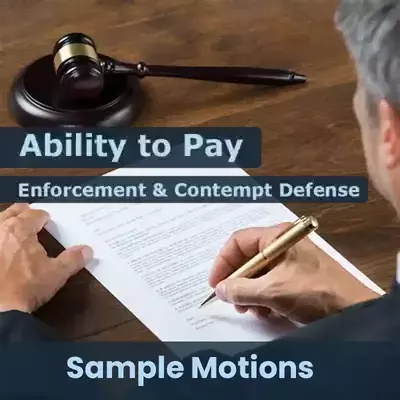Daily Tool: Equal Parenting Time Doesn’t Get You Equal Treatment from Social Security Administration
CATEGORY: Family Law Definition
Did you know that the Social Security Administration is going to discriminate against you if you put the words “primary residential parent” or “physical residence” of the child is the other parent in your final parenting plan or divorce decree even if both of you continue to have equal time and rights to your child!
You just might lose the child’s benefit check to the other parent even if you only put those words in so that the school could designate the residence for the school district.
How many of you thought that it was harmless to give in to the other parent and put the words “physical residence” into your agreement? And taking out the word “primary” isn’t going to help you either.
Here is an example of wording in an order that has caused the father to lose thousands of dollars to the other parent who is not on any disability or retired, that was intended to help supplement his lowered income when he retired so that he could continue to provide for the child more comfortably in his own home: (This could have been worded either way father or mother. This example is not to create any gender bias standard. This is just an example. If the mother were the one to create the benefit it rightfully should go to the mother than.)
“Mother’s residence shall be designated as child’s physical residence and goes on to say that both parents have “substantially equal time” and “as such each parent shall provide the essential needs for the child during their parenting time….Therefore under the circumstances no child support shall be paid by either parent to the other.”
That wording caused Social Security to select the parent who was named “physical residence” parent. Both parents have equal time and pays for the child themselves during the time they have the child. Didn’t matter with Social Security though even after the father presented evidence that he has the child more than half the time.
So if you think that you are going to automatically receive the benefit that is derived from your hard work to help you with your family’s support needs, remember that Social Security is not necessarily going to interpret your order the way that you think they will. So you need to be extremely cautious and clear in your order and leave nothing open to chance interpretations.
Before you agree to naming the other parent as a physical residence designation in your order, first ask yourself what is the purpose of having a designated physical residence or as sometimes called primary residence?
In order to avoid having this physical residence designation invade other aspects of your rights that perhaps you didn’t think of before like your taxes and social security, and being treated like a noncustodial parent because of assumptions, you might think of a different way to go about this.
I’m going to show you how to designate the primary residence of the child and not disadvantage either parent. When you go to finalize your final parenting plan and court order regarding your rights to your child, make sure that the wording in your final order reflects something like this:
Here is the wording: (Oh and take out the Texas code and put in your code for your own state)
“The Court finds that, in accordance with section 153.001 of the Texas Family Code, it is the public policy of Texas to assure that children will have frequent and continuing contact with parents who have shown the ability to act in the best interest of the child, to provide a safe, stable and nonviolent environment for the child, and to encourage parents to share in the rights and duties of raising their child after the parents have separated or dissolved their marriage. IT IS ORDERED that the primary residence of the child shall be the City of ___________(list the city where you want to restrict the child’s residence), ________ County (and the county), ____________ (then list the State) and the parties shall not remove the child from the City of ___________(list the city where you want to restrict the child’s residence), ________ County (and the county), ____________ for the purpose of changing the primary residence of the child until modified by further order of the court of continuing jurisdiction or by written agreement signed by the parties and filed with the court. IT IS FURTHER ORDERED that both ______________ (list the petitioner’s name) and ______________ (list the respondent’s name) shall share the right to designate the child’s primary residence within the City of _____, _____ County, ___ (state), while the child is in their respective possession.”
NOTE FOR COPYING THE ABOVE WORDING FOR YOUR ORDER: If you want to copy the wording for your order above from this blog post (check with an attorney to make sure that it complies with the rules and format for your orders in your state) and then just copy and paste into your document. If the copied material is in a shaded box, highlight the entire box. (The text just carried over the formatting from the blog post.) Right click anywhere on the highlighted text and a drop down menu will pop up. Use your mouse to go over to Styles at the top right of the menu that drops down when you right clicked on the text. Left click on the arrow under styles and then go down to the bottom left and click on “clear formatting.” This should take care of it and you should have normal text again with no shading.
Sometimes the things you think are little or minor could end up being a big deal later.
There are many reasons that you might be advised to add wording in your order that signifies one home is superior to the other one. Those reasons however are mostly antiquated or based off of old theories and beliefs. Mostly, we have come across people who believe that a child has to identify with one residence as their home or else they won’t develop a strong identity. Another is that the school requires it or the police if there was ever a problem.
The child hopefully will make memories in both of their homes and their identity is internal. So it is doubtful that they will be harmed by having two homes where they belong. In fact, it is more likely that the child has even more stability because they benefit from the security of both parents. And think about this, if the child’s identity was tied to the home then I guess we should be making it illegal for military parents to move their child all over the United States every year.
As for the schools and the police. They need to start updating their policies. If they cannot accommodate both families of the child, then it is time to review those policies and put in place new ones. Same with the police, they shouldn’t be treating one parent like they are more important than the other. Both of these policies send the wrong message to a child and cause them insecurity when they are with the parent that is being treated like they are second-class.
We hope that this helps you avoid thousands of dollars of loss in your family income in the future.
Keep coming back to this blog for other solutions and tools posted daily, as we help you explore your options and make your decisions easier to make on what is right for you and your family.
Take Care and see you back here tomorrow!
Read our book for citations of specific cases that you can use in your arguments to the court when you are arguing for the proper protection of your family rights.
[CLICK HERE to get the Parental Rights book “NOT in The Child’s Best Interest.]
You can learn more about this and how to reason through your rights and protect your rights in our books and courses. Click at the top on Store and you will find the books and training tabs. The book teaches you your rights and the training courses teach you how to argue them like I demonstrated above.]
Be sure to subscribe to our website and receive notices when the new Daily Tool is posted each day. Subscribe here: SUBSCRIBE
*We are not telling you to disturb the peace. This paragraph is a quote from the movie “Selma” 2014.
Strategic Parental Rights Strategist, Instructor, Constitutional Scholar, and Author
Divorce Solutions and Child Custody Solutions
Co-author “Not in the Child’s Best Interest” (Book on parental rights and children’s rights)
Co-author “Protecting Parent-Child Bonds: 28th Amendment” (Book includes guide for legislators)
Website: www.fixfamilycourts.com
Twitter: https://twitter.com/fixfamilycourts (@fixfamilycourts)
Facebook: https://www.facebook.com/pages/Fix-Family-Courts/324146134354536
YouTube: https://www.youtube.com/channel/UC_kKO3Xc_UT7ZeNU6OkYK0g



























